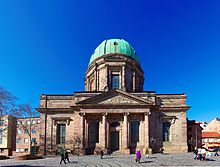

St. Elizabeth's is a Roman Catholic church in Nuremberg in southern Germany. [1] [2] It is dedicated to Elizabeth of Hungary.


St. Elizabeth's is a Roman Catholic church in Nuremberg in southern Germany. [1] [2] It is dedicated to Elizabeth of Hungary.
A chapel in the free imperial city of Nuremberg was dedicated to Elizabeth of Hungary in 1235. After the Reformation, this was the only Roman Catholic church in the otherwise Protestant city. It soon became inadequate for its congregation, and Catholic officials entered into protracted negotiations with the city magistrates, which lasted from 1718 to 1780, when agreement was reached that allowed for the construction of a new church building on the site.
The old church building was demolished in 1784. Franz Ignaz Michael Neumann, son of Balthasar Neumann, drew up plans for the new building and its foundation stone was laid on 19 May 1785. Neumann died on 29 September 1789, and his responsibilities were taken up by Peter Anton von Verschaffelt, who resigned in 1789 because his spending was exceeding the budget. The topping off was completed in 1802 and the dome was crowned with a golden cross in 1803.
In 1806 the church was secularised. On 27 January 1885, the Roman Catholic Archdiocese of Bamberg, whose territory includes the city of Nuremberg, purchased the building and by 1903 had completed the church to the original plans.
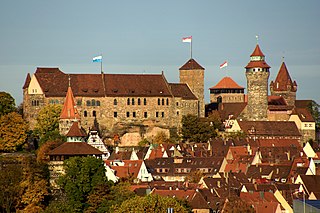
Nuremberg is the largest city in Franconia, the second-largest city in the German state of Bavaria, and its 544,414 (2023) inhabitants make it the 14th-largest city in Germany.
Nürnberger Land is a Landkreis (district) in Bavaria, Germany. It is bounded by the districts of Forchheim, Bayreuth, Amberg-Sulzbach, Neumarkt, Roth and Erlangen-Höchstadt, and by the city of Nuremberg.

Nyíregyháza is a city with county rights in northeastern Hungary and the county capital of Szabolcs-Szatmár-Bereg. With a population of 118,001, it is the seventh-largest city in Hungary and the second largest in the Northern Great Plain region. Its development has been ongoing since the 18th century, making it the economic and cultural center of the region. Nyíregyháza Zoo, with over 500 species, is recognized throughout Europe.

Nuremberg Castle is a group of medieval fortified buildings on a sandstone ridge dominating the historical center of Nuremberg in Bavaria, Germany.

The Cathedral-Basilica of Saint Louis, King of France, also called St. Louis Cathedral, is a Catholic cathedral and basilica in New Orleans, Louisiana. It is the seat of the Archdiocese of New Orleans and is the oldest cathedral in continuous use in the United States alongside the Royal Presidio Chapel in Monterey, California. It is dedicated to Saint Louis, also known as King Louis IX of France. The first church on the site was built in 1718; the third, under the Spanish rule, built in 1789, was raised to cathedral rank in 1793. The second St. Louis Cathedral was burned during the great fire of 1788 and was expanded and largely rebuilt and completed in the 1850s, with little of the 1789 structure remaining.

Carl Alexander Heideloff, also known as Karl Alexander von Heideloff, was a German architect, and master builder of Nuremberg. He is also known for his restoration of buildings and monuments.

Nuremberg Airport is an international airport of the Franconian metropolitan area of Nuremberg and the second-busiest airport in Bavaria after Munich Airport. The year 2018, with 4.5 million, was the year with the highest passenger volume to date at this airport. It is Germany's 9th busiest airport in 2022. It is located approximately 5 km north of Nuremberg's city centre and offers flights within Germany as well as to European metropolitan and leisure destinations, especially along the Mediterranean Sea, on the Canary Islands, in Turkey and in Egypt. The Airport is owned and operated by Flughafen Nürnberg GmbH, in turn owned 50% by the state of Bavaria and 50% by the city of Nuremberg.
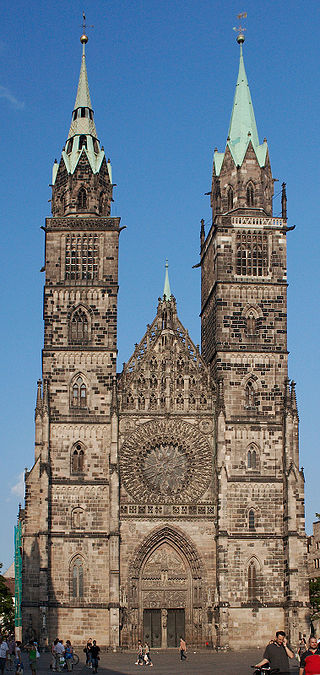
St. Lorenz is a medieval church of the former free imperial city of Nuremberg in southern Germany. It is dedicated to Saint Lawrence by the Roman Catholic Church. The church was badly damaged during the Second World War and later restored. It is one of the most prominent churches of the Evangelical Lutheran Church in Bavaria.
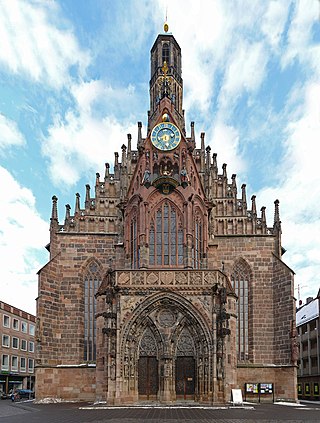
The Frauenkirche is a church in Nuremberg, Germany. It stands on the eastern side of the main market. An example of brick Gothic architecture, it was built on the initiative of Charles IV, Holy Roman Emperor between 1352 and 1362. The church contains many sculptures, some of them heavily restored. Numerous works of art from the Middle Ages are kept in the church, such as the so-called Tucher Altar, and two monuments by Adam Kraft. It has been a parish church of the Catholic Church since 1810.
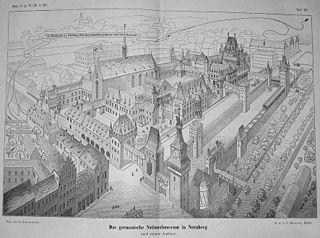
Nuremberg Charterhouse was a Carthusian monastery, or charterhouse, in Nuremberg in Germany. Its surviving premises are now incorporated into the Germanisches Nationalmuseum.
St. John the Evangelist Parish is a Roman Catholic church located in St. John, Indiana, United States. The Church was the first church in Lake County and was founded in 1839 by German immigrant John Hack. The present church has 1,335 families that belong to the parish. St. John the Evangelist Parish also has a private school called St. John the Evangelist School. The school contains grades pre-K through eight and has over 300 students enrolled.

The Church of St. Elizabeth of Hungary was a Roman Catholic parish church in the Roman Catholic Archdiocese of New York, located at 211 East 83rd Street, between Second Avenue and Third Avenue, on the Upper East Side of Manhattan in New York City. St. Elizabeth's was founded by Slovakian immigrants on the Lower East Side in 1891, and the Upper East Side building was completed in 1918. The Archdiocese of New York issued a decree to close the church on June 30, 2017.
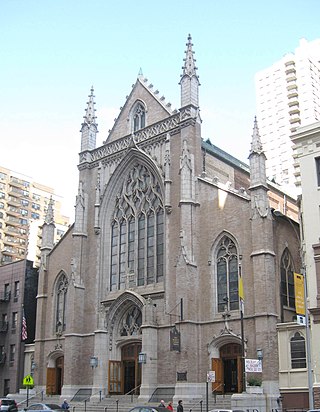
The Church of St. Monica, commonly referred to as St. Monica's, is a parish church in the Roman Catholic Archdiocese of New York, located at 413 East 79th Street, Manhattan, New York City. The parish was established in 1879 and in 2015 merged with nearby St. Elizabeth of Hungary and St. Stephen of Hungary churches.

The Church of St. Stephen of Hungary is a Roman Catholic church in the Archdiocese of New York, located at 402-412 East 82nd Street, Manhattan, New York City. The former parish of St. Stephen was administered by the Order of Friars Minor from its founding in 1922 until its merger with St. Joseph's in 2015.

The Nuremberg tramway network is a network of tramways forming part of the public transport system in Nuremberg, a city in the federal state of Bavaria, Germany. The system reached the neighboring city of Fürth from its opening year to almost a century later when construction of the U1 subway line led to the withdrawal of tram service to and within Fürth. During that era and referring to it historically in literature or nostalgic activities, the system was known as “Nürnberg-Fürther Straßenbahn“. For example, a local association dedicated to preserving the history and heritage of the tram network as well as old rolling stock calls itself “Freunde der Nürnberg-Fürther Straßenbahn“ The system is planned to cross the municipal boundaries of Nuremberg once more, if and when the extension to Erlangen and from there to Herzogenaurach dubbed "Stadtumlandbahn" opens.
St Egidien on Egidienplatz is the former Benedictine Abbey of Saint Giles (Egidienskirche), now a church in the former free imperial city of Nuremberg, southern Germany. It is considered a significant contribution to the baroque church architecture of Middle Franconia.
The following is a timeline of the history of the city of Nuremberg, Germany.

St. Jakob is a medieval church of the former free imperial city of Nuremberg in southern Germany. It is dedicated to Saint James the Greater. The church was badly damaged during the Second World War and later restored.

St. Martha is a medieval church in the old town of Nuremberg in southern Germany. It is dedicated to Saint Martha. Since 1800 it is a Reformed church, the community of which forms part of the Evangelical Reformed Church.

Nuremberg City Hall is located in the old town of Nuremberg, Germany, just east of the choir of the Sebalduskirche. It is part of the Historic Mile of Nuremberg as one of the city's sights. The imposing Renaissance building was designed by architect Jakob Wolff the Younger (1571–1620). It was severely damaged during World War II and was largely rebuilt in the 1950s. In the process, the structure was shortened by two window axes on the north side. On the south side is a core Gothic hall designed by Albrecht Dürer. The Lochgefängnisse, located in the basement, are considered a tourist attraction, as is the Beautiful Fountain, located directly in front of the New City Hall, designed by Kurt Schneckendorf and built from 1954 to 1956. This building replaced the row of houses between the Old Town Hall and the Hauptmarkt, which had been destroyed during the war.
49°26′58″N11°04′11″E / 49.44944°N 11.06972°E